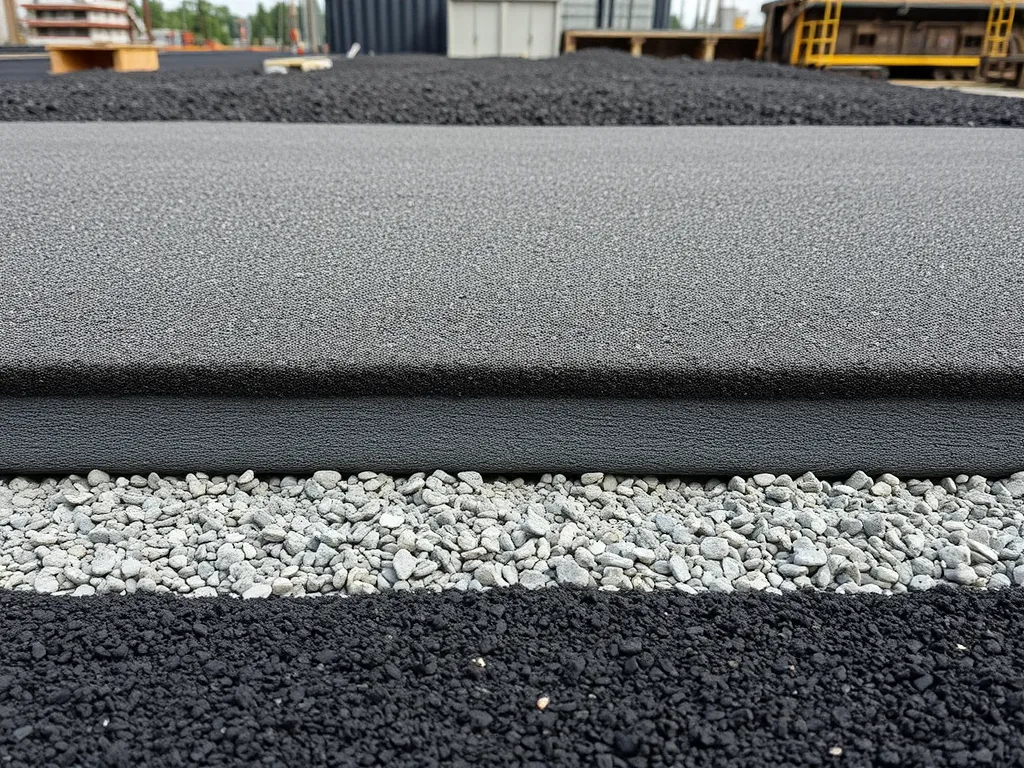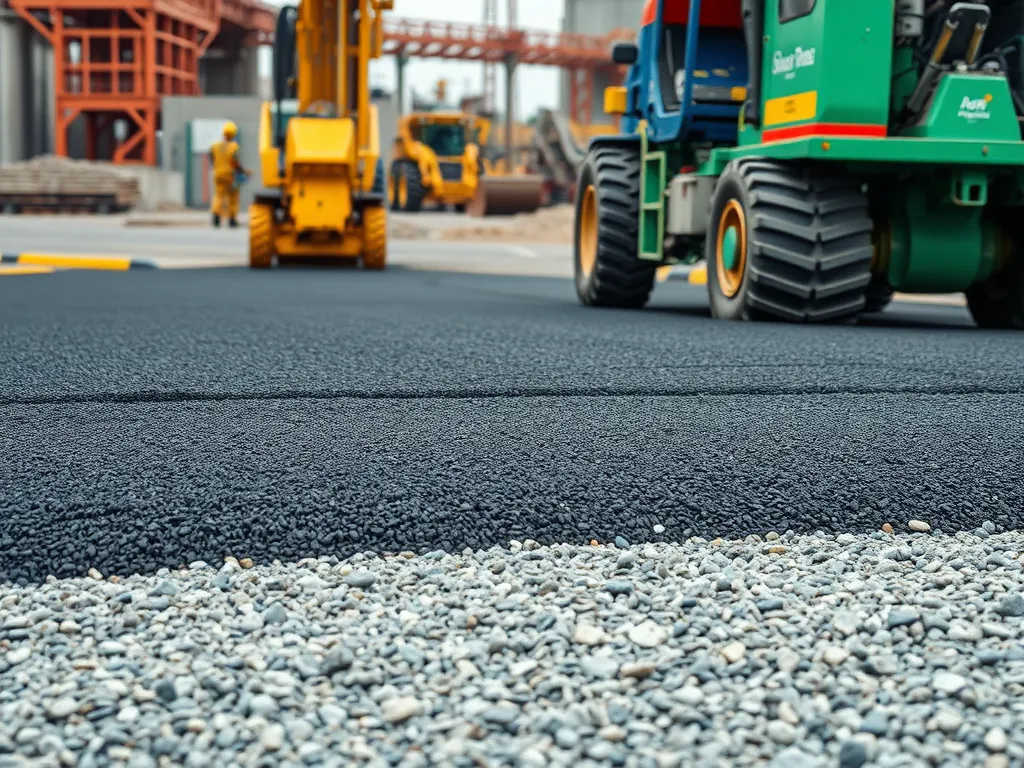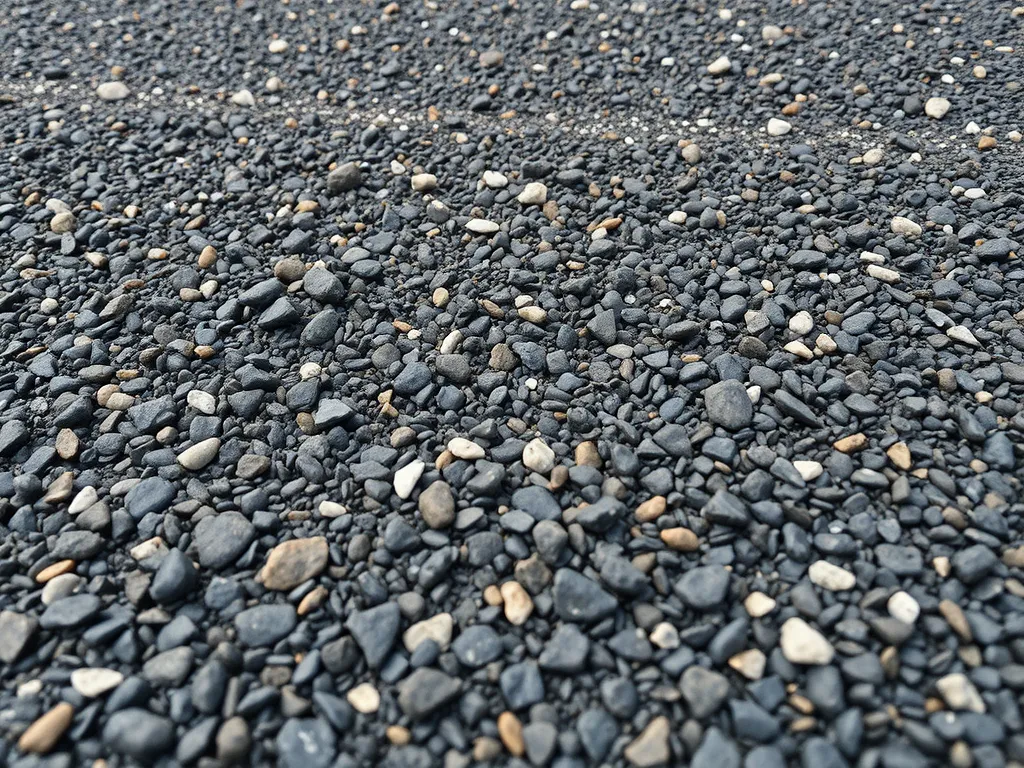Aggregate Size Impact on Asphalt Strength
Published on: May 31, 2025 | Last Updated: April 14, 2025
Written By: George Voss
Aggregate size directly determines asphalt strength by controlling load distribution and material density. Larger stones (3/4” to 1”) create structural stability through mechanical interlock, while smaller particles (under 1/4”) fill voids and prevent cracks. This balance affects heavy truck traffic support and freeze-thaw resistance in parking lots. Proper gradation—the mix of different aggregate sizes—along with compaction rates and traffic loads shape pavement durability. A 12% air void content in poorly graded mixes can reduce strength by 40%, making size selection vital for long-lasting roads.
This article breaks down how aggregate dimensions affect pavement performance. Learn why 3/4” crushed stone dominates highway mixes, how fine sands combat rutting, and why 1” aggregates work better for industrial lots than residential driveways. We’ll explore gradation charts, recycled material limits, and field-proven mix designs that meet AASHTO M323 specifications. Real-world examples show how a 10% increase in coarse aggregates can boost rut resistance by 30% in high-traffic zones.
Contents
Fundamentals Of Aggregate Size in Asphalt
Aggregate size determines how asphalt pavements bear weight, resist deformation, and handle environmental stress. Proper gradation creates interconnected networks that transfer loads efficiently while maintaining flexibility.
Role Of Aggregates in Asphalt Pavement Strength
Aggregates form 90-95% of asphalt concrete by weight, acting as the skeleton that carries traffic loads. Their angularity, hardness, and size distribution directly affect rut resistance and fatigue life.
Definition of Aggregate Size Gradation
Aggregate size gradation refers to the proportional distribution of particles from 0.075 mm (silt) to 50 mm (2″). The Superpave mix design system uses control points on 0.45-power gradation charts to optimize stone-on-stone contact.
Components of Asphalt Concrete Mixtures
| Component | Percentage | Function |
|---|---|---|
| Coarse Aggregates | 50-60% | Load bearing |
| Fine Aggregates | 25-35% | Filling voids |
| Mineral Filler | 5-10% | Binding particles |
| Asphalt Binder | 4-7% | Glue |
Types Of Aggregates in Flexible Pavements
Aggregates are classified by sieve sizes:
- Coarse: Retained on #4 sieve (4.75 mm)
- Fine: Pass #4 sieve but retained on #200 (0.075 mm)
Coarse vs. Fine Aggregate Functions
Coarse aggregates (12.5-25 mm) provide structural capacity but require thicker lifts (3-4″). Fine aggregates (0.075-4.75 mm) improve density but reduce air voids below 3% when overused. A balanced blend achieves 96% density during rolling.
These size interactions set the stage for examining how gradation choices affect load-bearing capacity. Next, we’ll analyze mechanical interlock patterns that determine pavement longevity.
How Aggregate Size Influences Asphalt Strength
Aggregate size shapes how asphalt handles weight, weather, and wear. The right mix of stone sizes boosts road life. Wrong picks lead to cracks, ruts, or weak spots.
Mechanical Interlock and Structural Performance
Coarse aggregates lock like puzzle pieces. Angular rocks (crushed stone) grip better than round ones (gravel). This grip forms a stiff frame that resists bending under truck loads. Tests like ASTM D3515 track this as “Marshall Stability” – higher values mean tougher pavement.
Effects Of Maximum Aggregate Size on Load Distribution
Bigger stones spread weight across wider areas. A 1.5-inch top layer handles semi-trucks better than 3/4-inch. But thick layers need deeper paving – 3 inches minimum for 1.5-inch stones. Thin layers with large rocks crack faster under stress.
Smaller Aggregates: Density and Crack Resistance
Fine fills gaps between big stones. Sand and tiny rocks (under 3/8 inch) pack tight, cutting air pockets by 2-5%. This:
- Blocks water seepage (main cause of cracks)
- Boosts freeze-thaw resistance (AASHTO T 283 test)
- Allows smoother roller work
Too much fines (over 8% passing #200 sieve) weakens the binder grip.
Larger Aggregates: Stability Vs. Workability Trade-offs
Big stones (1 inch to 1.5 inch) resist rutting in hot zones. But:
- Harder to roll flat – needs 150°F+ mix temps
- Risk of stone pockets if not enough binder
- Limit to 60-70% coarse in most Superpave mixes
Best for base layers: 3/4-inch NMAS (Nominal Max Aggregate Size) gives 3,000+ lb Marshall Stability. Top layers use 1/2-inch NMAS for smoother rides.
Picking stone sizes isn’t just big vs small – it’s about layer depth, traffic types, and local weather. Next, we’ll break down how to match these factors to your project needs.

Critical Factors in Aggregate Size Selection
Choosing the right aggregate size requires balancing multiple engineering priorities. The decision affects pavement lifespan, maintenance costs, and structural integrity under real-world conditions.
Pavement Thickness and Traffic Load Requirements
Aggregate size must match the pavement’s design thickness. Heavy-duty roads handling semi-truck traffic (20,000+ lb axle loads) typically use 1.5-inch maximum aggregate size in base layers. For residential driveways (4-inch thickness), 0.75-inch aggregates prevent surface raveling. The AASHTO M323 standard specifies aggregate gradation based on traffic ESALs (Equivalent Single Axle Loads). A 12-inch interstate highway layer might combine 60% coarse aggregates (1″) with 40% fines for interlock.
Gradation Design for Optimal Compaction
Proper gradation ensures aggregates lock together without air voids. The Superpave system uses a 0.45-power gradation chart to plot particle sizes. Ideal mixes have:
- Coarse aggregates (3/4″ to 1.5″) forming 65-75% of total weight
- Intermediate sizes (3/8″ to 3/4″) at 10-15%
- Fines (≤3/8″) filling remaining voids
Poorly graded mixes risk VMA (Voids in Mineral Aggregate) exceeding 16%, reducing density by 8-12%.
Balancing Durability With Thermal Stress Resistance
Larger aggregates improve rutting resistance but increase thermal cracking risk. A 2021 NCAT study showed pavements with 1″ aggregates had 40% fewer ruts than those with 0.5″ stones in 120°F heat. Conversely, mixes with >25% coarse aggregates (>3/4″) showed 2x more thermal cracks at -20°F. Solutions include:
- Polymer-modified binders (PG 76-22) for wider temperature ranges
- Blending 50% 1″ limestone with 30% 0.5″ gravel and 20% sand
Next, we’ll explore advanced mix design strategies that fine-tune these variables for maximum asphalt strength.
Also See: AASHTO T209: Determining Maximum Specific Gravity
Mix Design Strategies for Enhanced Strength
Smart asphalt design uses precise aggregate blends to boost road life. Focus on three core methods: blending dense-graded aggregates, balancing coarse material, and stopping mix separation.
Principles Of Dense-graded Aggregate Blending
Dense-graded mixes pack tight by using a full range of aggregates. These blends fill 95-98% voids when compacted. The secret? Pair large stones (3/4″ to 1.5″) with sand and mineral filler. ASTM D3515 sets the standard for this “stone skeleton” method. Proper grading locks particles in place, cutting rut risk by up to 40%.
Optimizing Coarse Aggregate Proportions
Coarse aggregates (over 3/8″) form the backbone of strong pavements. For heavy truck routes, aim for 50-60% coarse material. But balance matters—too much creates air pockets. A 55% coarse, 35% fine, 10% filler split often hits the sweet spot. Test data shows this mix boosts Marshall Stability values by 15-20% versus poorly graded batches.
Avoiding Segregation in Asphalt Mixtures
Big size gaps in aggregates cause separation during hauling or paving. A 1″ top layer needs stones no larger than 3/4″. Use layering: place 2-3 lifts for thick pavements. Keep mix temps above 280°F during placement. Proper handling keeps strength even, preventing weak spots that crack under 10-ton axle loads.
These mix tactics set the stage for greener methods. Next, we’ll explore how smart grading cuts waste while keeping roads tough.

Environmental Considerations
Selecting the right aggregate size does more than boost pavement strength—it supports sustainable construction. Proper gradation and recycled material integration cut environmental impacts while maintaining structural integrity.
Resource Efficiency Through Gradation Optimization
Optimizing aggregate size gradation reduces raw material use by 10-15% in typical mixes. Superpave specifications (Superior Performing Asphalt Pavements) target specific gradation curves to achieve 4% air voids, requiring less bitumen. Key benefits:
- Lower quarrying needs: Balanced coarse-to-fine ratios minimize waste
- Reduced binder demand: Tight particle packing cuts bitumen use by 8-12%
- Extended pavement life: Dense-graded mixes resist rutting, delaying repairs
For example, a 19mm maximum aggregate size in base layers paired with 4.75mm fines creates interlock without excess voids. This balance meets AASHTO M323 standards while conserving resources.
Recycled Aggregate Size Compatibility
Reclaimed Asphalt Pavement (RAP) now constitutes 15-30% of mixes nationwide. However, inconsistent RAP aggregate sizes—often ranging from 25mm chunks to fine dust—require careful processing:
- Screening: Separates RAP into size-specific batches (e.g., 10mm, 14mm)
- Crushing: Reduces oversized chunks to match virgin aggregate gradation
- Binder adjustment: PG 64-22 binders often supplement aged RAP binder
Mills report 18% higher tensile strength when RAP aggregates are size-matched to virgin materials. A Florida DOT study found 25% RAP with 12.5mm processed aggregate performed equal to all-virgin mixes in Marshall Stability tests.
These environmental strategies set the stage for addressing common questions about aggregate selection in pavement design.
FAQs: Aggregate Size and Asphalt Strength
What Size Aggregate is Best for Asphalt?
The best aggregate size for asphalt depends on the specific application and traffic conditions. Generally, a mix of 3/4-inch coarse aggregates is effective for highways, while smaller aggregates around 1/2 inch are better suited for residential driveways. It’s crucial to consider factors such as pavement thickness and vehicular load when selecting the optimal size.
What is the Effect Of Maximum Aggregate Size on Asphalt Strength?
Maximum aggregate size plays a significant role in distributing load across the pavement. Larger aggregates can handle higher loads but may require deeper layers for adequate support. Conversely, smaller aggregates can improve density and crack resistance, leading to better overall strength and durability of the asphalt pavement.
Why is Aggregate Size Critical for Asphalt Performance?
Aggregate size is critical because it affects the mechanical interlock between particles, which influences load-bearing capacity, stability, and resistance to cracking and deformation. Properly sized aggregates create a well-compacted structure that enhances the pavement’s performance and longevity.
Does Larger Aggregate Always Increase Asphalt Strength?
No, larger aggregates do not always increase asphalt strength. While they can improve stability and resistance to rutting in certain conditions, they also risk issues like difficulty in achieving proper compaction and increased potential for thermal cracking under extreme temperatures. The key is to balance the size and gradation of aggregates to match the pavement’s intended use.

Closing Thoughts
Aggregate size significantly impacts the strength of asphalt pavements. Understanding these dynamics aids in selecting the right materials for optimal performance. Smaller aggregates improve density and crack resistance, while larger aggregates enhance stability but may challenge workability. Striking the right balance involves considering traffic loads, pavement thickness, and environmental factors.
For more insights into asphalt strength and to explore effective mix design strategies, check out Asphalt Calculator USA. Your resource for building resilient pavements.
Additional Resources for You:
- The Asphalt Institute (Technical Resources & Standards)
- (PDF) A New Framework for Understanding Aggregate Structure in Asphalt Mixtures
- Study on the influence of aggregate strength and shape on the performance of asphalt mixture – ScienceDirect
- The Impact of Aggregate Quality and Size on Your Asphalt Mix — Pavement Management Services
- Selecting the correct materials – Asphalt magazine


